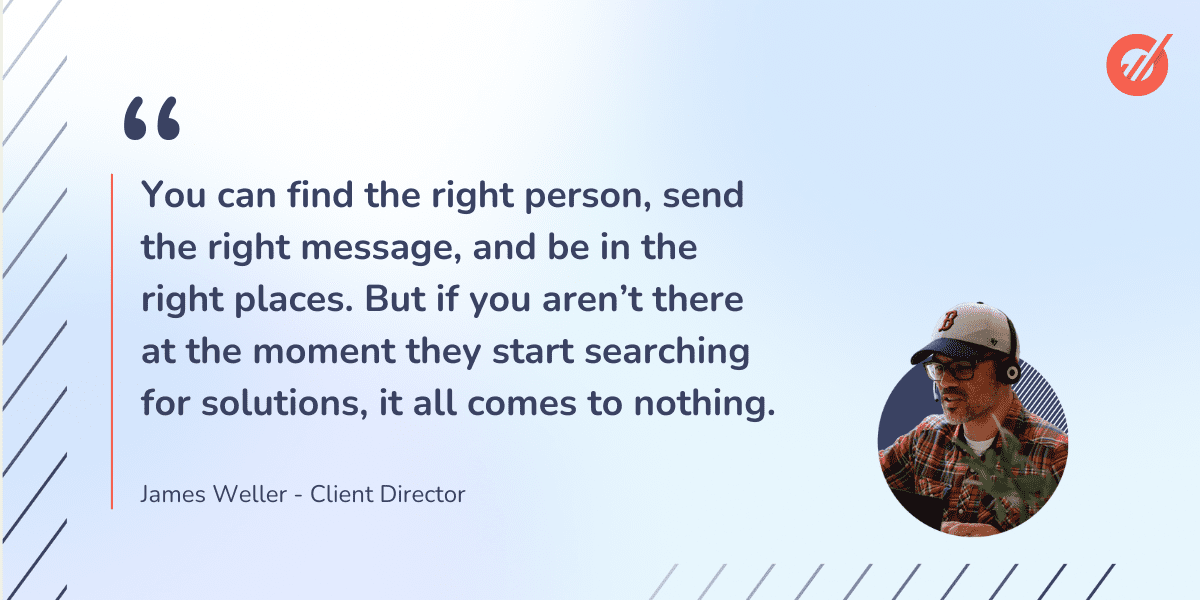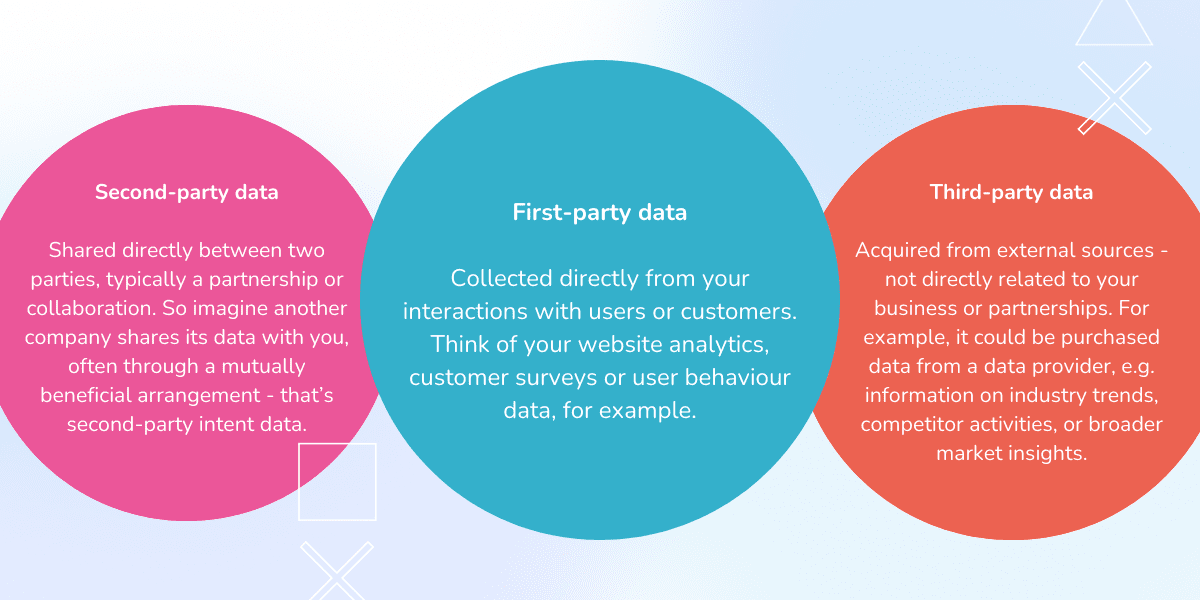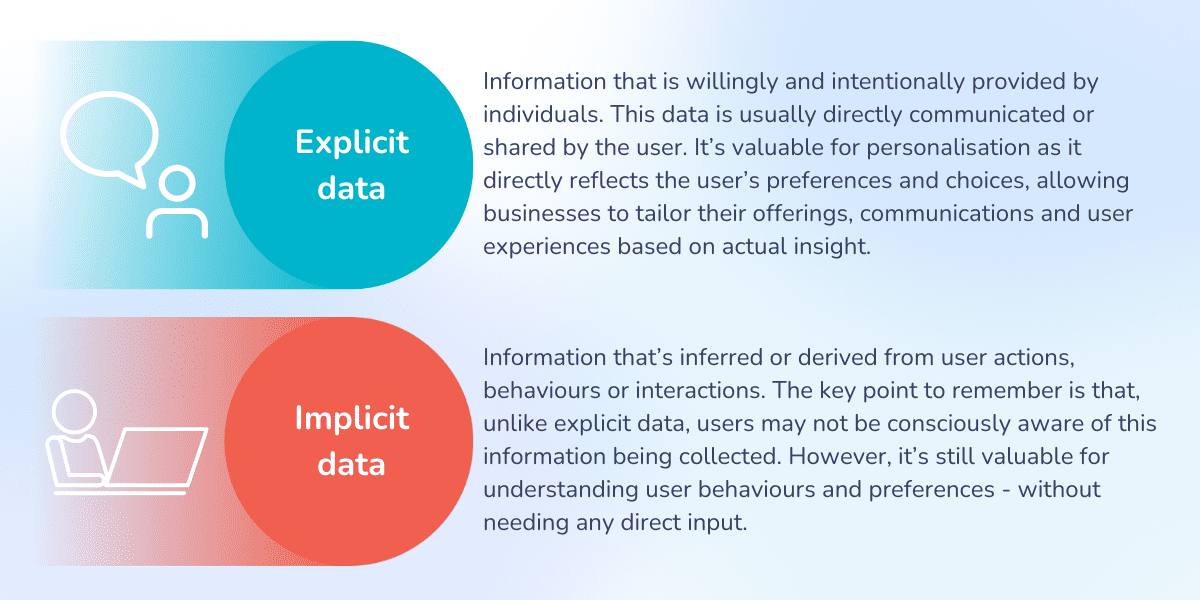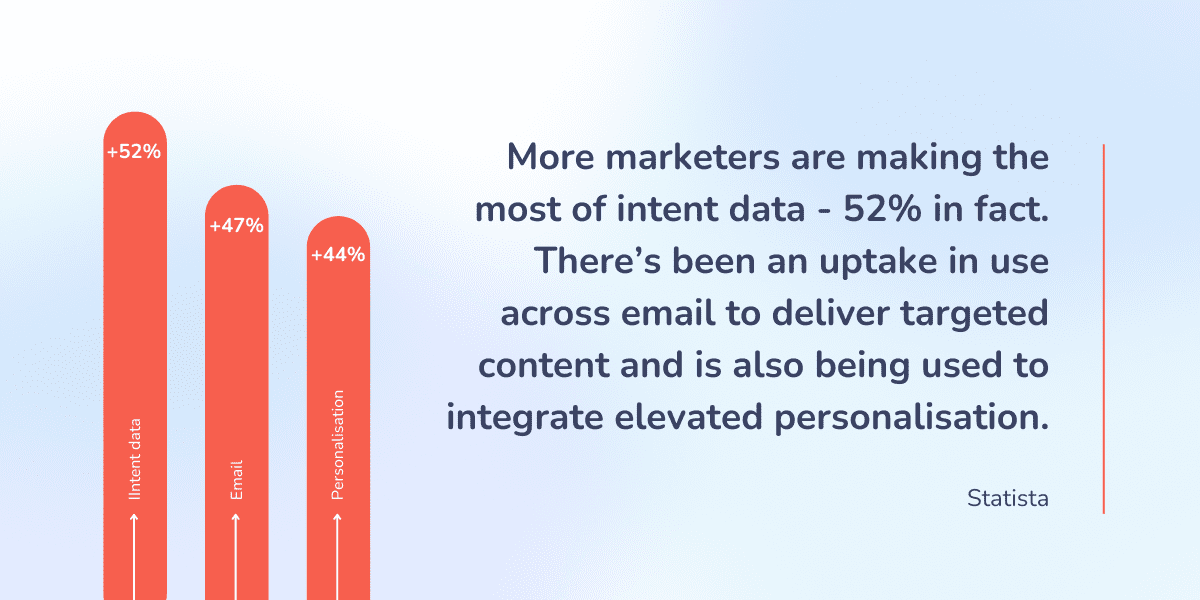How to use B2B intent data to supercharge your campaigns
In this blog
- What is intent data?
- What’s the difference between first, second and third-party intent data?
- What role does intent data play in B2B marketing and sales?
- How has intent data evolved with technology?
- Sales trigger events vs. intent data
- So how do you recognise buyer intent?
- How does Sopro use intent data?
- What are the benefits of intent data?

B2B intent data tells you how serious a potential customer is about buying, so you can offer them the perfect solution at the right moment. Here’s how you can use this powerful tool to superpower your sales approach.

So, what’s the secret sauce for prospecting success?
Quality B2B buyer intent data.
In today’s competitive landscape, the savviest leaders use this type of data to understand which prospects are ready to buy. Importantly, that means they can avoid wasting valuable time and resources on those who aren’t.
But just how prevalent is intent data in the B2B marketplace, exactly?
Well, even back in 2020, it was predicted that 70% of B2B buyers would be utilising indent data more often by now. What’s more, it was recently reported that around 40% of businesses are dedicating more than half of their marketing budget to intent data.
Impressive.
However, the thing is: although more organisations are collecting buyer signals, further research suggests that only 39% are leveraging this data effectively (Forrester).
But you know what? ????
It’s easy to see why there’s some confusion when intent data can be so complex
Don’t worry, though, If your business is struggling to make sense of the signals, you’re certainly not alone.
From what it is to how to use it effectively, we’re going to take you through everything you need to know.
What is intent data?
Intent data (or buyer intent/purchase intent data) provides insight and signals into what your target audience is likely to do next online, e.g. buy a product from you or one of your competitors.
Just think of it as the digital footprints users leave when they navigate online.
“Buyer intent ensures you engage with your customers at the right time,” says Sopro Client Services Director, James Weller.
Sounds simple enough, right?
Sure. But there’s more than one type of intent data to consider.
What’s the difference between first, second and third-party intent data?
We’ll go into more detail about the different types of data later, but here’s what you need to know first:

Regardless of which type of intent data you use, though, this level of insight feels like a no-brainer for your biz – right?
In theory, yeah.
The thing is, although intent data is super valuable for B2B businesses, it’s hardly ever used effectively by the teams that need it most: sales and marketing.
What role does intent data play in B2B marketing and sales?
We’re not exaggerating when we say that intent data plays a crucial role in B2B marketing and sales.
Well, the stuff that works, anyway.
Why? Because it can help fill in the blanks, painting a hyper-realistic portrait of who your prospect is – and how ready they are to buy. Sales and marketing can then tailor their strategies based on real-time insights as opposed to, often, outdated guesswork.
Here are just a handful of ways it can help empower both sales reps and marketing professionals:
- Identifying potential buyers – crucially, potential customers who’ve actively shown interest in your products, services or solutions. Consequently, sales and marketing teams can then focus all of their energy on warmer leads that are likely to convert.
- Personalisation and targeting – analysing intent data allows teams to create relevant content marketing and tailored messaging with a higher chance of engagement.
- Timely engagement – speaking of which, intent data gives you a much better idea of timing, too. For example, whether your prospect is considering their options or close to hitting the checkout.
- Lead scoring and prioritisation – this means sales can rank potential leads more effectively and focus their efforts accordingly. Crucial when that chunky pipeline’s crashing your Excel export.
- Content strategy optimisation – it also helps marketers learn which content resonates the most with their target audience. Consequently, they can create compelling content that pops out of the feed and piques the interest of prospective buyers.
- Improved retargeting efforts – finally, intent data allows businesses to implement retargeting campaigns. This ensures relevant ads or content are presented to potential prospects who’ve shown interest but haven’t gone on to purchase.
But this is just the start of what technology can do when it comes to today’s intent data.
How has intent data evolved with technology?
Historically, B2B intent data used to rely on things like a prospect’s website visits and search activity. But with technological advances, data sources now include a much broader range of signals. These include things like:
- Social media interactions
- Marketing content, e.g. emails, videos, gated content like whitepapers, blog posts, etc.
- Event attendance
- Third-party sources and artificial intelligence (AI)
Amazingly, the latter has also enabled real-time tracking so businesses can monitor or analyse buyer intent as it happens. Add to this powerful machine learning and predictive analytics – tools that can accurately analyse historical data patterns, identify trends, and predict future buying behaviour – and this game has changed significantly from where it started.
But how does this stack up with the more traditional sales tools?
Sales trigger events vs. intent data
The most obvious point of comparison is sales trigger events. These are specific occurrences within a business or industry that create opportunities for sales or marketing.
And you know what?
There’s evidence to suggest they still work too. Research shows that reaching out to prospects based on trigger events can increase conversion rates by up to 400%. ????
But the thing to remember is that, unlike intent data, they’re not focused on online behaviour.
Here’s a quick 3-point crib sheet to help:
1. Key difference – sales trigger events focus on significant changes in the business environment, while intent data revolves around prospect’s online actions and behaviours.
2. Timings – in terms of timescales, sales trigger events often occur far less frequently. However, they can have a profound impact when they do. Intent data is more continuous and provides insights into ongoing buyer interest and engagement.
3. Use cases – Essentially, sales trigger events help identify the ideal moments to reach out. For instance, if a company announces a new initiative that aligns with your product or service or you’ve become aware of some new regulatory changes that gives your team a valid reason to reach out.
On the flip side, intent data assists in personalising communication based on a prospect’s demonstrated interests. Your marketing team could be using analytics tools to identify companies and individuals who are actively engaging with content that’s in your wheelhouse – again, giving you a reason to reach out.
Who comes out on top? Neither. Sales trigger events and intent data both have a place in any decent sales or marketing workflow. So let’s call it a draw. ????????
Arguably, sales trigger events are easier to spot though. Especially if you keep an eye on industry news and trends.
So how do you recognise buyer intent?
As you can probably gather by now, there’s no one way to gauge buyer intent. In fact, the B2B sector interprets intent data much differently than B2C, SaaS and eCommerce companies. It looks at factors like:
- Search intent – by analysing search queries related to industry-specific solutions or products, B2B companies can recognise when businesses are actively looking for service that aligns with their offerings.
- Engagement data – they assess engagement with content like whitepapers, case studies and webinars to identify any decision-makers who have shown an interest.
- Firmographic data – this is used for targeting companies of a certain size, industry, or revenue range; businesses that align with your ideal customer profile.
- Technographic data – finally, this data helps identify the companies that have, either adopted or are researching, specific technologies relevant to your products.
That’s not the end of this data stream though.
Much like your prospect’s day-to-day interests or motivations, their intent can be complex and multifaceted. For example, there are key differences between implicit and explicit intent data to consider.
In a nutshell…

By combining this type of implicit and explicit insight, businesses are now able to paint pretty accurate customer portraits in real time Here are some key indicators of buyer intent to look out for and, importantly, how to analyse them:
Website visits
Sure, it’s an oldie but this still comes top of the list for a reason. Frequent visits to your website, particularly when landing on product or pricing pages are a great indicator of buyer intent. Analyse website visits with:
- Page views and sessions – track which pages are being viewed the most frequently to start understanding the areas of interest.
- Bounce rate – next, assess the percentage of visitors who leave the site without interacting at all.
- Conversion Rates – finally, monitor the conversion rates on key pages, e.g. pricing or product pages. This should indicate high-intent actions.
Sales prospecting is the process of developing new sales opportunities by finding and contacting potential clients. It’s based on one-to-one outbound marketing activities, such as an email, phone call, or LinkedIn message.
Sopro’s multi-channel prospecting service includes detailed intent data on named prospects from within your campaign – including the pages they visit, when, for how long, and if they return. And with IP Match and Engage included, Sopro turns your anonymous website traffic into named businesses, and then uses your targeting criteria to add relevant prospects to your engagement campaign, just as they are researching your business.
Content engagement
Interactions with relevant content, e.g. downloading whitepapers, case studies or product documentation also demonstrate some intent. If a prospect is going to submit their email address in an age of so much spam, they must be at least vaguely interested, right? Measure content engagement using:
- Engagement metrics – gauge interest by looking at things like time spent on content, scroll depth and interaction rates.
- Content performance – Identify which pieces of content resonate the most with audiences based on views and interactions.
Email engagement
On the subject of spam, taking the time to open and click through your emails (especially those containing product information, pricing details or special offers) is obviously a good sign. So, track email engagement using:
- Open rates – check out initial interest by monitoring how many recipients open your emails.
- Click-through rates – then analyse the percentage of email recipients who click on links to understand any deeper engagement.
In the SaaS industry? Read our guide to email-led SaaS marketing strategies for more tailored information.
Search queries
Specific search queries around products or services signal active consideration – especially those indicating comparison or reviews. There’s no bigger seller than social proof.
- Keyword analysis – examine search queries related to your products or services to understand user intent.
- Search ranking – monitor how well your website ranks for relevant search terms to assess visibility. That’s the fundamentals of organic search sorted. Now, when it comes to your paid ads, go on to analyse:
- Click-through rates (CTR): assess how well ads are performing in terms of generating clicks.
- Conversion tracking – analyse how many ad clicks result in desired actions, e.g. form submissions or product purchases.
Social media engagement
Much like social proof is a powerful indicator that things are going well, likes, shares, comments or direct engagement on your social media platforms can also signify interest in your products, Track these using:
- Engagement metrics – track likes, shares, comments and clicks on your social media posts to gauge audience engagement.
- Sentiment analysis – then go even further, assessing the sentiment of social media mentions. This can help you understand how the audience perceives your brand.
Demo /trial requests and webinar attendance
Requests for product demonstrations, free trials, or samples are strong signs a prospect is in the evaluation phase. Similarly, active participation in your webinars or virtual events is also a positive indicator that things are going well. Still, you can double down even further by analysing:
- Attendance rates – track and compare the number of attendees and their interactions over a set of virtual or physical events.
- Post-event surveys – then gather qualitative feedback to further understand attendee sentiments and other areas of interest.
Form submissions
Simply filling out website forms with their contact details indicates a willingness to engage further. But you can get more insight into buyer intent by looking at:
- Form submissions – track the number of (real human-being) form submissions on your website, especially those related to demos, trials or inquiries.
- Conversion paths – then go on to analyse the typical paths users take on your site that lead to conversions.
Competitor comparison
Are prospects comparing your products against competitors? Sounds like they’re deep into the decision-making stage and intend to buy. You can get even more valuable insight by looking at:
- Share of voice – understand how frequently your brand is mentioned in comparison to competitors.
- Content analysis – analyse engagement towards competitor content. This will help you to identify areas of interest for shared target audiences.
- Sentiment analysis – analyse customer feedback and reviews to understand overall sentiment towards your brand and the competition.
- Keyword extraction – you can also go even further by identifying key phrases or terms used by customers in reviews. This could be to express specific interests in products and features or any pain points.
Budgetary inquiries
Of course, explicit inquiries about pricing, payment plans or discounts are a tell-tale sign prospects are evaluating their options. And, these days, chatbot analytics can be a great help by tracking things like:
- User queries – these tools can analyse common user queries to understand their interests.
- Conversion rates – they can also track how many chat interactions lead to meaningful actions or conversions.
Internal champion identification
Finally, recognition of an internal champion or decision-maker within their organisation can signal a move towards those final stages of the buying process. Look to third-party intent data analytics to help with:
- Scoring and segmentation – you could apply scoring models to prioritise leads based on their demonstrated intent signals.
- Integration with CRM – then integrate third-party intent data with CRM systems for a holistic view of customer interactions.
Sound like a lot of work? Sure, it can be.
Thankfully, there are expert data providers and tools that won’t just help you find the insight; they’ll do the legwork with it too. ????
How does Sopro use intent data?
At Sopro, we believe buyer intent is a crucial part of any decent multi-channel campaign.
How, exactly?
Well, our research into The State of Prospecting 2024 shows that 70% of companies can track the website activity of a cold prospect if they engage with their campaign and 62% identify the companies that visit their website using IP matching.
That’s why we ensure all prospects can be fully tracked from an email to your website. This includes who they are, which pages they’re visiting and when.
We also monitor traffic from our client’s websites, tracking IP addresses to see if any visitors are a good match. So when they’re visited by a company that’s not in their campaign but matches their customer profile, we’ll add any relevant decision-makers into an engagement campaign. And when IP match is known to increase lead volumes by 14.7% and lead quality by 37.6%, that’s nothing to sniff at. ????
Sopro uses our award-winning email prospecting service as the foundation for intent-based multi-channel campaigns. So we only release phone numbers or follow up on other channels when people show some interest.
For example, we use buyer intent as a trigger to send InMail messages and connection requests. Consequently, 4.8% of the trigger events ended in a meeting booked and 55% of the InMail responses progressed into an active dialogue where the client continued to nurture the lead.
Makes sense when there’s a ton of evidence to support the fact that LinkedIn prospects respond much more favourably to sales approaches when they’re familiar with the brand.
But you know what? These are just some of the benefits of blending quality intent data with a multi-channel approach.
What are the benefits of intent data?
We’d all like to think we’ve got the market covered with the perfect product.
But there’s research to suggest that just 10% of your potential customers are actively looking to buy.
And that makes timing so important for bolstering your sales efforts and tailoring any digital activities. And this is where intent data truly comes into its own…
Timely targeting
Buyer intent data helps businesses recognise and react to potential opportunities. It allows for timely and relevant outreach which can result in higher engagement and conversion rates.
Focused prioritisation
Buyer intent data allows sales teams to focus their efforts on leads that are actually likely to convert. This ensures that resources are allocated efficiently, improving overall sales productivity.
Personalised outreach
Understanding buyer intent enables businesses to plot a well-thought-out content strategy, before going on to craft hyper-personalised messages. You know, the stuff that empathises and actually talks to their pain points; it’s this personalised approach that’s likely to build a meaningful connection with the potential customer. The stats don’t lie either.
Improved lead nurturing
Buyer intent data enables businesses to understand exactly where prospects are in the sales funnel. This insight allows for the creation of nurture campaigns that guide prospects through the buying process. Crucially, you can provide them with the right information at the right time.
Competitive advantage
Is your prospect about to start weighing up their options? Recognising buyer intent allows businesses to proactively engage potential customers before their competitors do. Don’t take our word for it though; 94% of marketers believe using data to track buyer intent gives marketing and sales teams a competitive advantage.
Optimised ad spend
With buyer intent data, businesses can target advertising efforts towards audiences actively seeking solutions. This ensures that marketing resources are invested in reaching prospects with a higher likelihood of conversion.
Data-driven decision-making
Buyer intent data provides actionable insights that businesses can use to adapt and refine their strategies. Whether it’s adjusting marketing campaigns or refining product offerings, data-driven decisions contribute to overall business success. Simple as that.
But as technology continues to advance, this is just the tip of the iceberg. ????
To conclude
In today’s crowded marketplace and cost-of-living crisis, this type of insight is giving B2B companies an edge when they need it most.
By harnessing the power of intent signals, you can wave goodbye to cold calls or second-guessing the buyer journey. Just deeper insight to superpower your sales process and bring your marketing efforts to life. And, perhaps most importantly, fill your sales pipeline with more qualified leads for years to come.
But high-quality intent data is just one piece of the puzzle.
Combine intent data with multi-channel prospecting and you can rest assured that every message reaches your ideal customer – and when they’re ready for it too.
Ready to start integrating intent data into your strategies? We’ve got tons of actionable insights that can help in our new whitepaper: The State of Prospecting in 2025.





Share